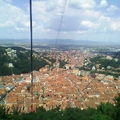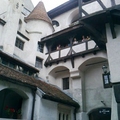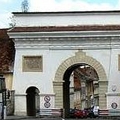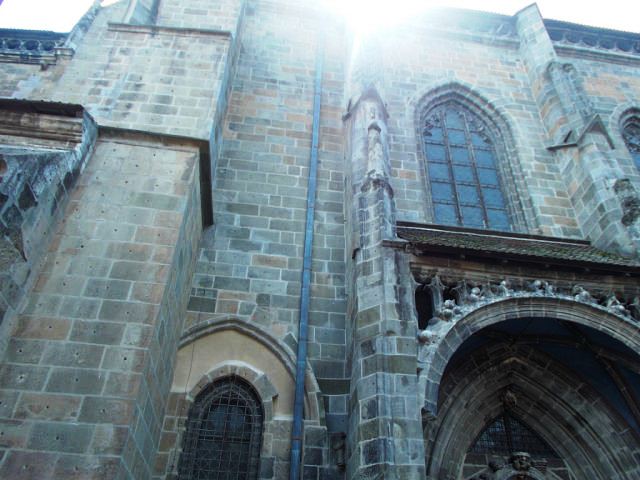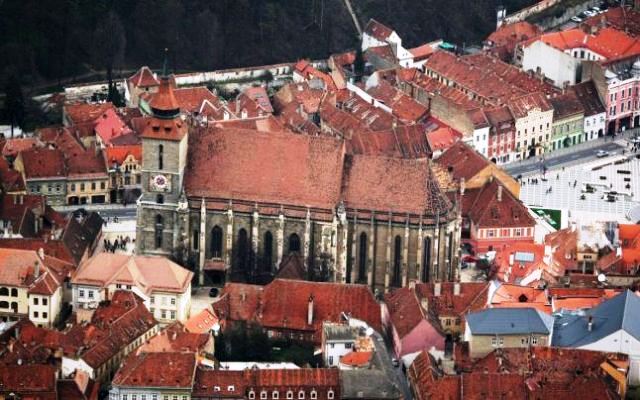Destinations / The Best Places to Visit in Brasov, Romania / The Black Church
The Black Church
The geographical strategic position of Brasov, close to Rucăr- Bran commercial route through the Carpathians influenced its economic development over time. Due to its proximity to Bucegi Mountains and the Bran Castle, Brasov is one of the most important destinations in Romania.
The Black Church is the heart of Brasov Over 500 years old, the Black Church is the most representative monument of Brasov, the largest Gothic church in Transylvania and, as some historians say, the greatest religious church from Vienna and Istanbul. Moreover, inside the church is one of the most wonderful organs in Europe and the largest collection of antique rugs from Asia Minor.
The construction of this Evanghelical gothic church started around 1380, during the vicar Thomas Sander, and was originally called St. Mary's Church. In 1421, much of the building was destroyed during the Turkish invasion, that’s why was completed only in 1477. It is considered the largest place of worship in Romania, with impressive dimensions: 90 meters in length, 25 to 37 meters in width and a cross tower that reaches 65 feet, it can house around 5,000 people . Moreover, the tower is located in the country's largest bell that weighs 6.3 tons. Then, after almost 200 years, in 1689 a fire destroyed a part and the smoke blackened the walls and the exterior could not be restored. The renovation took about 100 years, but because the black walls from the smoke it was nicknamed the Black Church . Also the roof 20 feet high was built after the smoke. Craftsmen who worked on the restoration of the town were coming from Danzing, that is why the new baroque vaults are not gothic.
Black Church’s Organ
Black church’s organ, with 4000 pipes is considered among the largest in Europe, was built between 1836-1839 by the organ builder Buchholz in Berlin and is famous for its sonority. In 1924, the organ gallery was extended to organize large concerts with the participation of sacred music choir. Over the years they were made countless vinyl records, cassette tapes and CDs. Moreover, currently a concert is organized every week.
Priceless Values
The collection of old carpets from Brussa regions, Usak and Ghiordes of Asia Minor, from the XVII-XVIII is a priceless treasure of the Black Church. They have been donated over the years by craftsmen guilds in the city of merchants and citizens.
Black Church - Brasov.
The furniture and other objects of worship are remarkable values that make Brasov a place that no tourist can avoid . For example bronze font, crafted by local artisans, was donated in 1472 by the vicar Johannes Reudel. After almost 150 years, in 1716, made a beautiful Meensen Hannes blacksmith wrought iron railing surrounding the baptismal font. Then, on the southern porch, there is a mural made after 1476, representing the Virgin Mary with baby Jesus, located between St. Catherine and St. Barbara. At the bottom of the painting is the coat of arms of King Matthias Corvinus and his wife Beatrice of Naples, Aragon. It also cannot be overlooked three leaves with five panels at the altar of Feldioara (late fifteenth century). Lateral pews are dated from the late eighteenth century and the first half of the eighteenth century, is crafted with baroque ornaments, carved in wood. Then the choir pews are in Gothic style, dating from 1866 and the nave banks made of oak, were mounted in 1937.
Old gravestones of Brasov personalities were built in areas west side of the hallway when we worked to raise Gothic altar (1866) and the building heating system (1937). An oil painted canvas representing the "Wedding at Cana", the work of painter Hans Eder, was exposed in the front of the ship north side.
The emblem of the city, the crown of a tree trunk with roots, is represented, in relief, on pole in front of the pulpit. Inside the church there are a number of statues, the oldest is of the St. John the Baptist. The other represents St. Thomas, St. James Pilgrim, Jesus Salvator Mundi, Virgin Mary, Paul, Luke and Sebastian.
The Statue of a Child
A statue not typical for a place of worship is exposed on the north buttress. It is the representation of a child like he is falling. The legend says that when the church was being built, a craftsman became envious of a very talented apprentice. At one point he asked the child to pick up something from the ledge and when he bent over, the master shoved. The legend says that the statue was erected by the other disciples, in memory of the dastardly assassination.
Over time the Black Church was subject to several maintenance and renovation. The statues on the external buttresses were replaced by children in the years 1937 - 1944 and the originals were housed inside the church. Between 1967 - 1977 were allocated money from the state budget for the renovation and restoration after the earthquake of 1977 was achieved with help from donations and fundraising. According to estimates tourism annually pass through the Black Church 100,000 tourists, considered the second place of interest in the county, after the Bran Castle .
Visitation schedule is daily between 10.00 and 17.00 at a rate of £ 4 for adults and £ 2 for students and pensioners. At the entrance there is the sale for general picture postcards with details. Photography and filming is prohibited. Accommodation can be found in the surroundings, the hotels and boarding houses.
Others from The Best Places to Visit in Brasov, Romania
Due to numerous historical and artistic monuments Brasov is one of the most important tourist centers of the country.
The city is divided into two distinct components: the area with baroque influence that winds from the foot of the mountain and the massive Postavaru and the large area with buildings and factories.
The main attraction is the old town - Schei, yet glamorous, where you will find plenty of houses and antiques, especially religious.
Brasov is located in the central-eastern part of Romania, at the foot of Tampa (967m).
The administrative territory of Brasov is within the southern part of the basin Brasov, in the internal flow of the Eastern Carpathians.
The region consists of two distinct units: Brasov and the Carpathians and at the contact between them developed a series of activities following the foothills of external factors, namely , Sacele and Rasnov.
Brasov climate is temperate continental specifically characterized by a note-type transition between temperate oceanic and the continental temperate: wetter and cooler mountain areas with relatively low rainfall and temperatures slightly lower in low areas .
Temperature inversions are numerous, therefore, minimum winter temperatures do not fall in the extremes, the annual average of 7.
6 degrees Celsius.
The rainfall is relatively high due to the small diurnal contrasts.
Historical data: Brasov is documented in 1234 in the Catalogue Ninivensis named Corona.
In the second half of the XIV century, is confirmed as the administrative and ecclesiastical center of Barsa, (Corona, Kronstadt, Brasso), "free royal city" one of the economic and cultural centers of Transylvania.
In the Renaissance, "Brasov these times stands out, compared to other cities, the cultivation of the sciences" noted in 1548, the great humanist and reformer Johannes Honterus sas (1498-1549), in a letter to Sebastian Munster, professor of University of Basel.
The prestige of the school and library founded by Honterus in 1541 - Studium Coronense - was to attract students from all over Transylvania, Hungary, Germany and the Netherlands.
Johannes Honterus introduced religious reform Barsa Saxons, and in 1547 the Principality Diet accepted Lutheran religion as one of the four official religions allowed in Transylvania.
Between 1639 and 1641, Brasov fortifications are amplified in the north of the city with several rows of curtains and moats.
Bastion in 1646 ended the defensive system works.
In 1689, the most devastating fire in the history of Brasov affects most important buildings of the Citadel.
Weight restoration unfolds city and rebuild the destroyed buildings is consistent with new styles: Baroque, Rococo, Classical.
The transformation from a medieval town into a modern city imposed extension to the north-east (toward Old and Blumana) and west (toward Schei), by demolishing the fortified seat of the city that began in 1857 (Gate Street and fortifications therein), Street Wear Black (1873), Fair Gate Horses (1874), Bastion (1886), Bastion harness (1887).
The old moats, ponds and swamps were filled, rose administrative and public buildings, schools, barracks and houses were decorated with parks and promenades.
Nowadays Brasov is one of the most beautiful cities of Romania to be visited with many , many places of visit that attract tourist all over the world all the year round.


